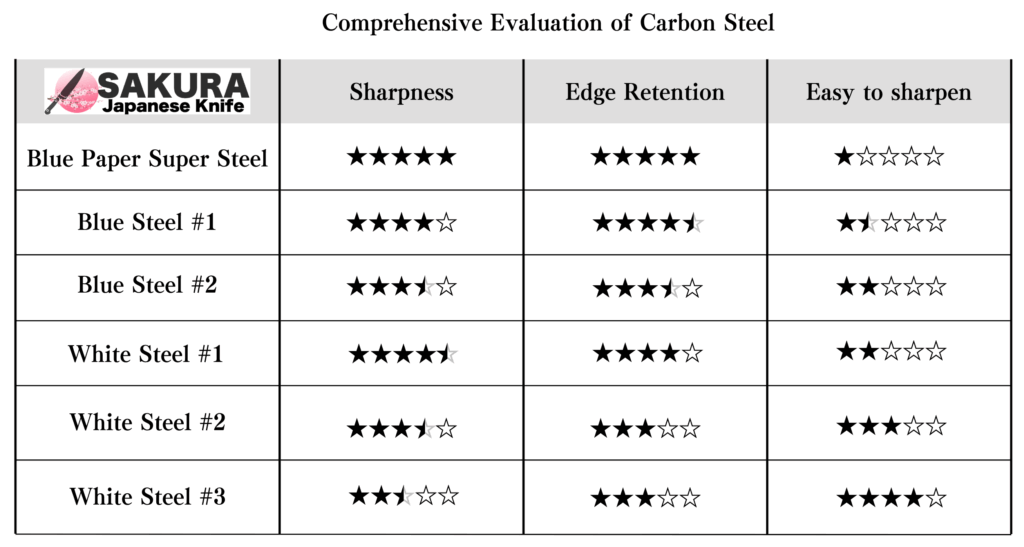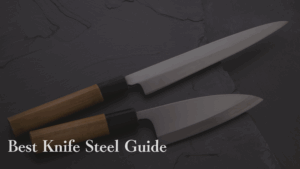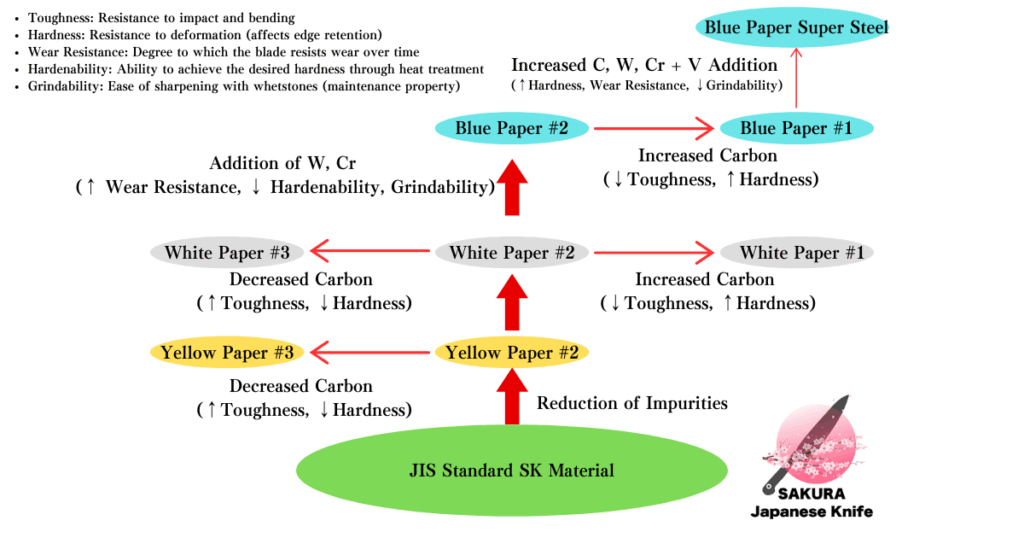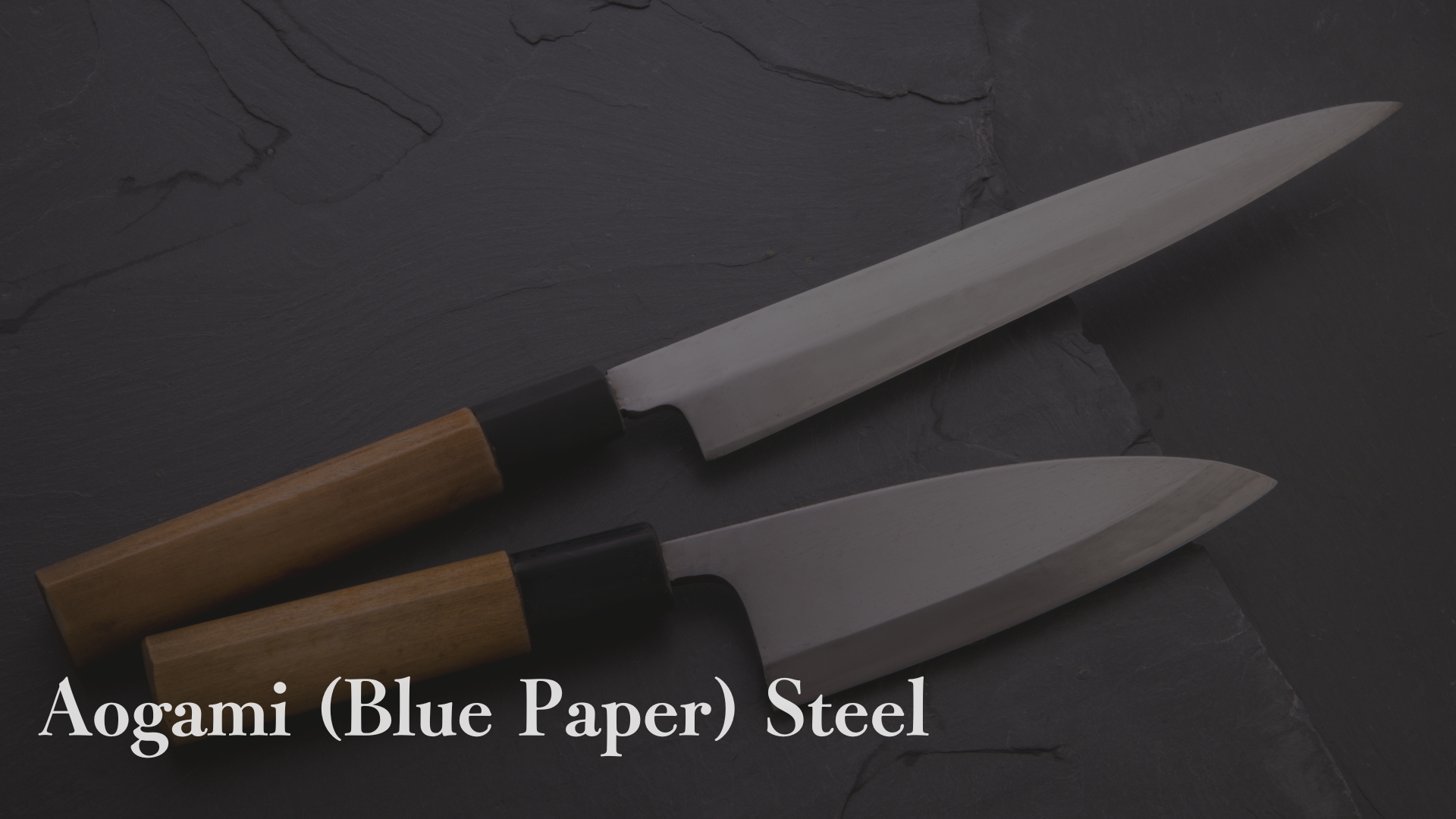Have you ever found yourself thinking, “I wish I could slice through ingredients more smoothly,” or “If I’m getting a new knife, I want one that will last for years”?
I know I have. Back when I used to cut tomatoes with a cheap stainless-steel kitchen knife, they would often end up squashed rather than cleanly sliced. I remember feeling so frustrated, muttering “This is so hard to cut…” each time.
But then one day, I came across a knife forged from something called Aogami (青紙鋼, meaning “Blue Paper steel”) at a traditional blacksmith’s shop.
I was instantly smitten by its cutting performance. The blade slid through food so cleanly and effortlessly that it gave me a little rush—almost like my cooking skills had suddenly leveled up!
Aogami might sound unfamiliar (just like its counterpart Shirogami, or White Paper steel). In fact, even typing aogami-kou into a Japanese computer won’t convert to the kanji without a special effort, which shows you how uncommon the term is in everyday use.

Both Aogami and Shirogami are part of the family of high-quality Yasugi steels produced by Hitachi Metals, each distinguished by its carbon content and added alloys.
In this article, we’ll cover the basics of what Aogami (Blue Paper) steel is, how it differs from Shirogami, and take an in-depth look at the high-end Aogami Super steel – including its features and drawbacks.
Worried about rust or maintenance? We’ll also address those concerns with practical tips, so you get a complete, real-world picture of what it’s like to use a Blue Paper steel knife.

What is Aogami Steel? Pronunciation & Basics of “Yasugi Blue Paper” Steel
How to Pronounce 青紙鋼 (“Aogami-kō”)
First off, how do you say 青紙鋼 in Japanese? Many people might guess “seishi-kō” from the kanji, but it’s correctly pronounced “aogami-kō.” (青紙鋼 literally means “blue paper steel.”)
Even native speakers don’t see this word often—Japanese IME (input typing) usually won’t convert aogami-kou to the proper kanji without selecting it from a list—so don’t worry if it’s new to you.

Yasugi Steel and Aogami Steel – What’s the Connection?
Yasugi steel (安来鋼, Yasugi-kō) is named after Yasugi City in Shimane, Japan.

This region’s steel has a legendary reputation worldwide for making high-end blades and even traditional Japanese swords. Aogami steel is one of the prized variants of Yasugi steel.
Essentially, Aogami is a high-carbon Yasugi steel with a special mix of alloying elements (like chromium and tungsten) added to the iron and carbon.
By tweaking the recipe this way, Aogami achieves an excellent balance of properties: it has the hardness and carbon content for top-notch sharpness, plus added elements to improve its toughness and a bit of rust resistance.
In short, Aogami is a Yasugi carbon steel formulated to hold a sharper edge longer and be less prone to chipping or rusting than a plain high-carbon steel.
The Appeal of Aogami Steel Knives: Incredible Sharpness and Rust Considerations
Why Are Aogami Blades So Sharp?
The first reason is the high carbon content. Carbon is crucial for making steel hard and capable of taking a very sharp edge.
Aogami (Blue Paper steel) is made with a relatively high percentage of carbon, which is a big part of why knives made from it can be insanely sharp.
Of course, making a blade super hard isn’t enough by itself—you also need it to be durable. This is where the precise blend of alloys in Aogami steel comes into play.
Elements like chromium and tungsten are added in just the right amounts to increase the steel’s toughness (its resistance to chipping or breaking) without sacrificing that hardness.
The result is an ideal knife material that “cuts like crazy but isn’t fragile.” It’s the kind of balance you might imagine in a legendary samurai sword that can slice through an opponent’s blade without shattering.
Is Rust an Issue for Aogami Steel?
Now, Aogami is a high-carbon steel, so it can rust if you’re careless – it’s not as stainless as, well, stainless steel. However, as long as you wipe the blade dry after use and avoid leaving it wet, you really don’t need to worry too much.
In normal kitchen use, if you get into the habit of cleaning and drying your knife promptly, an Aogami steel knife can serve you for years without developing more than a harmless patina.
Speaking of patina, some knife enthusiasts actually enjoy the “rust” color that forms on carbon steel over time. Instead of seeing it as ugly corrosion, they see that gradual blue-gray patina as a sign of a well-loved knife.
Just like a leather wallet gaining character with age or raw denim fading to that perfect worn-in look, a carbon steel knife develops a unique appearance the more you use it.
At that point, it’s not just a tool – it’s a treasured partner in the kitchen. (I have to admit, my own happiness goes up when I’m using a knife I’ve taken good care of!)
Aogami vs Shirogami: Differences, and Aogami Super’s Features & Pros/Cons (Comparison Table)
When choosing a traditional Japanese knife, you might wonder: “So, which is better, White Paper steel or Blue Paper steel?” To help compare these popular Yasugi steels (and introduce Aogami Super), take a look at the table below, which outlines their characteristics side by side:
| Aspect | White Paper Steel (Shirogami) | Blue Paper Steel (Aogami) | Aogami Super (Blue Super Steel) |
|---|---|---|---|
| Features | Very pure carbon steel with minimal impurities; focuses on extreme sharpness. | Yasugi steel with added alloy (chromium, tungsten, etc.) for improved durability and slight rust resistance; well-balanced sharpness and edge retention. | An even more alloy-rich version of Blue Paper steel for higher hardness and toughness (premium performance). |
| Advantages | Can achieve an incredibly keen, razor-sharp edge. | Offers a great balance between sharpness and edge retention (stays sharp longer than White). | Excellent edge retention – stays sharp for a long time. Highly regarded by professional chefs and enthusiasts. |
| Disadvantages | Rusts very easily; edge dulls faster compared to Blue. | Still prone to rust (needs care); slightly pricier than White. | Expensive (premium price). Also harder to sharpen due to its high hardness. Not stainless (care still required). |
| Rust Resistance | Low – very prone to rusting. | Moderate – a bit better than White steel, but still requires diligent drying. | Moderate – better than regular Blue, but nowhere near stainless-level rust resistance. |
| Price Range | Broad range: from budget-friendly up to mid-tier. | Generally mid-range to high. | High-end only – often found in top-tier, artisan knives. |
| Ideal For | Purists chasing the absolute sharpest edge and willing to do regular maintenance (sharpening, oiling). | Cooks who want a balance of sharpness and durability, and don’t mind some upkeep. | Professional or hardcore users who want the best performance and are willing to invest (and maybe splurge a bit). |
As a general guideline, many people start with a White steel knife and then graduate to a Blue steel knife as they become more experienced or want a blade that stays sharp longer.
In the end, you’ll want to try different steels and see which one feels right for your cooking style and preferences.
Next, let’s talk specifically about Aogami Super, which is kind of the “ultimate” version of Blue Paper steel with its own quirks.
What is Aogami Super? Merits & Demerits of Using This Steel
Aogami Super (also known as Blue Super steel) is a premium high-carbon blade steel made by Hitachi Metals. It’s basically the top grade of the “Blue Paper” Yasugi steels – think of it as Blue Paper steel on steroids.
Among the Aogami series, Aogami Super contains the largest amount of alloying elements (like tungsten, chromium, molybdenum, and vanadium in addition to the carbon). Thanks to this rich composition, Aogami Super has some standout characteristics:
- High hardness – it can be heat-treated to an even higher hardness than standard Aogami.
- Long-lasting sharpness – the edge holds for a very long time due to excellent wear resistance.
- Ultra-sharp edge potential – you can hone it to an extremely fine, razor-like edge.
This steel is often used in high-end kitchen knives and fine woodworking tools where top-tier sharpness and durability are required.
Merits of Aogami Super
Because Aogami Super is harder than the other Yasugi steels, knives made from it can go longer between sharpenings – the cutting edge simply stays sharp longer. The knife’s performance remains stellar even through heavy use, which is a huge plus if you’re a professional chef prepping a lot of food.
Another merit is its trusted reputation. Aogami Super has a kind of cult status among knife aficionados and professionals; it’s known to be a reliable, top-of-the-line steel. If you pick up an Aogami Super knife, you’re using a blade that many experts would agree is among the best of the best in terms of raw performance.
That said, Aogami Super might be overkill for a total beginner. It’s a high-performance material, which means it shines brightest in the hands of someone who can appreciate that long edge life and who knows how to care for it properly. (There’s nothing wrong with starting on a simpler steel and “upgrading” to Aogami Super once you’re ready.)
Demerits (Drawbacks)
The first obvious drawback of Aogami Super knives is price. They tend to be expensive – all that performance doesn’t come cheap! If you see a knife labeled Aogami Super, chances are it’s in the high-end tier, sometimes costing hundreds of dollars and often crafted by skilled artisans.
Next, because the steel is so hard, sharpening can be a bit more challenging. Aogami Super blades don’t grind away as easily on a whetstone, so you’ll need proper technique and a bit of patience (or the help of a professional sharpener) to tune up the edge. The flip side is you won’t need to sharpen it as frequently as a softer steel.
Lastly, remember that Aogami Super is still a carbon steel at heart. It’s not stainless, so you must take the same precautions: wipe down and dry the blade after use, and maybe oil it before storage. It’s less forgiving about moisture than stainless steel knives – leave it wet and it will spot or rust. So while it’s “super” in many ways, it’s not magic; good knife care is still required.
White or Blue Steel: Which Should You Choose?
So, White vs. Blue – which one is right for you? It really comes down to your priorities and how much maintenance you’re up for. If you absolutely insist on the sharpest edge possible and don’t mind a bit of extra work (and perhaps you’re on a tighter budget), a White Paper steel knife is a fantastic choice. White steel blades can take a wickedly sharp edge, perfect for precision cutting – as long as you’re willing to sharpen them more often and keep them dry.
On the other hand, if you prefer a knife that will hold its edge longer and you want a bit more forgiving nature in terms of upkeep, then a Blue Paper steel knife is likely the better fit. Blue steel’s added alloys give it that extended edge life and a touch more rust resistance, which can be really convenient in day-to-day use.
In my opinion, starting with a White steel knife is a great way to learn. You’ll gain experience in sharpening and caring for a high-carbon blade. After you’ve mastered that, you’ll probably appreciate the jump to a Blue steel knife – the longer edge retention and slightly easier maintenance will feel like a reward for your efforts. (For what it’s worth, I began my own knife journey with a Shirogami blade before moving up to Aogami.)
Maintenance for Longevity: Tips to Prevent Rust on Aogami Knives
Owning a carbon steel knife like an Aogami blade means you’ll want to give it a bit of extra TLC to keep it performing beautifully for years. Here are some simple maintenance tips to prevent rust and keep your Blue Paper steel knife in top shape:
- Wipe the blade immediately after use: Water and acidic juices from foods are the enemies of carbon steel. As soon as you’re done cutting, wipe the blade clean and dry with a cloth or paper towel. Even a quick wipe goes a long way toward preventing rust spots.
- Dry it thoroughly after washing: Never leave your knife to air-dry. After washing (with just water or a mild soap), hand-dry the blade completely. Get into all the nooks, and make sure no moisture remains. Store the knife in a dry, well-ventilated place.
- Oil the blade for storage: If you won’t be using the knife for a while, or just periodically as extra protection, apply a thin coat of oil to the blade. You can use food-safe mineral oil or a specialized knife oil. This creates a barrier against moisture and slows down any potential corrosion.
- Enjoy the sharpening process: Maintaining an Aogami knife also means embracing the process of sharpening it on a whetstone. Regular sharpening will keep that edge as good as new, and many enthusiasts find it rewarding to bring the knife back to razor sharpness. (Since Aogami Super is very hard steel, don’t worry if you decide to have a professional sharpen it until you get the hang of honing such a hard blade yourself.)
By following these steps, you’ll keep rust at bay and ensure your Blue Paper steel knife stays a trusty kitchen companion for a long time.
Conclusion: Knowing Aogami Steel Makes Knife Selection More Exciting
The allure of Aogami steel lies in its exceptional combination of a scary-sharp edge and just enough rust resistance to be practical. Once you’ve felt how smoothly an Aogami knife slices (and noticed that it’s not too finicky as long as you care for it), it’s hard not to fall in love. Step up to its higher-grade sibling Aogami Super, and you get truly top-tier performance – it’s no wonder this steel captivates so many pro chefs and knife enthusiasts.
Meanwhile, Shirogami (White Paper) steel has its own special charm. It’s revered for the pure sharpness of its edge and the smooth feel you get when sharpening it. Honestly, whether you go with White steel or Blue steel, you’re in for a treat; each offers a slightly different experience, and discovering those differences is a joy in itself. That’s the fun of exploring these traditional Yasugi steels – there’s no single “best” for everyone, just the best for you.
If you’re worried about maintenance or rust, it’s true that stainless steel knives can be a safer bet for hassle-free use. They’re convenient and certainly get the job done. But trust me, the incredible sharpness and the connection you develop with a carbon steel knife (like one made from Aogami) is on a whole different level. Once you get into it, you might find that a little extra care is totally worth it for the sheer pleasure of using such a knife.
“It might take a bit more effort, but it will make your cooking more fun.” If that idea resonates with you, then I wholeheartedly recommend peeking into the world of Aogami and Aogami Super steels. You’ll likely discover that using one of these knives elevates your kitchen experience, making everyday cooking feel just a bit more special.
(On a personal note, I still use stainless steel knives for convenience sometimes – nothing wrong with that! But when I take the time to maintain and use a carbon steel knife, I often catch myself at the end of the day wiping it down lovingly and thinking, “This knife really did great work today.” Caring for your tools and using them thoughtfully can turn a routine task into something truly rewarding. Embrace your knife, and happy cooking!)

コメント